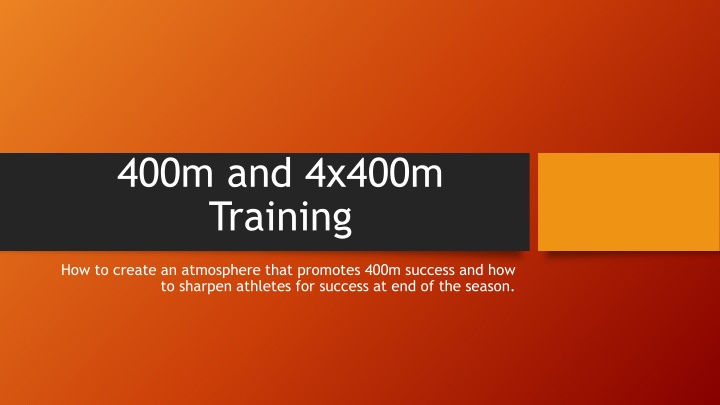Mastering the 400m and 4x400m Training: Keys to Success
Tips for creating a supportive training atmosphere that fosters success in the 400m and 4x400m events, as well as strategies for sharpening athletes for peak performance towards the end of the season. Emphasizing the importance of mental toughness, promoting positivity, and treating 400m sprinters like true sprinters can lead to consistent excellence in these challenging races.
Download Presentation

Please find below an Image/Link to download the presentation.
The content on the website is provided AS IS for your information and personal use only. It may not be sold, licensed, or shared on other websites without obtaining consent from the author.If you encounter any issues during the download, it is possible that the publisher has removed the file from their server.
You are allowed to download the files provided on this website for personal or commercial use, subject to the condition that they are used lawfully. All files are the property of their respective owners.
The content on the website is provided AS IS for your information and personal use only. It may not be sold, licensed, or shared on other websites without obtaining consent from the author.
E N D
Presentation Transcript
400m and 4x400m Training How to create an atmosphere that promotes 400m success and how to sharpen athletes for success at end of the season.
Why were here I HAD TO DIG FOR IT GO TO THAT DARK, DARK PLACE THAT ALL QUARTERMILERS KNOW -Jack Wellenstein
Setting the Tone for Your Program Why the 400m?
Why the 400m or 4x400m? Why should the 400m be important? The 400m is the great uniter of your team It brings together hurdlers, distance and sprinters It creates mental and physical toughness Why is the 4x400 important to your program? It is the most exciting race of the meet (not because it s the last) The rule of proximity rules when you have a good one, drives performance when you don t
How do you promote the event? The 400m is scary for young kids I make the 4x400 relay the primetime event of the meet Do you make the event about pain or pride? I always focus on positivity when it comes to the event With new athletes I don t talk about how much the race will hurt, but rather how tough they are Our program takes a distinct pride in excelling at the 4x400m Through that we have been very consistent in the 400m and the other sprints
Treat your 400m sprinters like SPRINTERS Training your 400m sprinter should have a focus on speed, not endurance This helps to recruit sprinters to try out the event I make every one of my sprinters run a 400m each year I NEVER tell a 400m guy to go out relaxed Mental cues have to match the expectations of the race Relaxed = slow Aggressive = fast
Finding your possible 400m guys Is there an ideal body type for the 400m? Ideal is great, but we deal in reality Stride length, frequency and mechanics are more important Attitude can make up for physical short falls Desire is essential Look for an athlete with something to prove Mental toughness and patience Plan for the future I tab 2 3 freshmen each season that will be in the 400m project
Warning!!! KEEP IT SIMPLE! You may have all of the education and background as anyone, but an average 15 year old kid doesn t care. Be careful of making things more difficult than need to be Don t be married to the plan! BE FLEXIBLE!
Pre-season Speed development must be set up before you begin any type of endurance training. Speed is 25 times more difficult that endurance to develop -Tony Veney
Preparing for healthy and efficient sprinting 100m, 200m, 400m, hurdlers, jumpers all train the same way We start in the beginning of December with learning the basics Teach Teach Teach Use this time to teach your leaders so they can assist during the season with the young ones Drill into them your dynamics and sprint drills for warm-ups Use this time to focus on technique and skill acquisition
Warm-up Daily Parts Reflexive Performance Reset (RPR) (Chris Korfist, Cal Deitz, Tony Holler) Sprint Drills Focus on range of motion and quality Does it mimic qualities of good sprinting (high knee, good pelvic position, good posture) Build-ups 6-8 x 60m (focus on strong arms and strong, powerful strides) 3-4 with standing start 3-4 with fall-in start
Warm-up Special add-ins (1-2 times per week) Wickets (start with wood slats, progress to mini hurdles) Hurdle walkovers Booms (use different arm placements and movements) Toe pops (use different surfaces and focus on body control and reaction bounce) During season I add in warm-up quarters a few days a week
Is the ability there? Coordination/Rhythm Important for any sprinter, especially a 400m runner Smooth speed is crucial for a 400m (If your athlete can t run a fast 200, then its hard to expect a fast 400) Is your athlete fast enough to hit the goals you have for them? We use wickets for this During winter we use 8 wood slats During the season we start with the mini hurdles and extend out to 16 20 Use to work on rhythmic speed and core stability
Where is the energy going? Ankle Stiffness A stiff ankle is critical for applying force from the hip through the foot into the ground If your ankle joint deforms when it hits the ground you lose energy Key to acceleration, start and speed! Toe pops Done over varied surfaces Done for height, distance, back and forth, side to side
Soul of the runner Hip Flexors Importance of the psoas Asafa Powell Booms (quick, bringing knee above parallel, focus on good finishing position. The hammer down also fires the glute) Hanging leg raises/incline leg raises/flat leg raises Partner assisted leg raises
Sample Workout for December/January Monday: RPR, speed drills, 6 build-ups 4 x 10m, 4 x 20m, 4 x 30m (pure acceleration work) Hanging leg raises, Booms Wednesday: RPR, speed drills, 6 build-ups Wickets (straight through, pistols 2x, hugs 2x, arms up 2x, straight through) Depth jumps, Cat jumps, Split squat jumps, RDL Step-ups Friday: RPR, speed drills, 6 x build-ups Hand-timed 40 yd with timed flying-10m (with Freelap) Toe Pops (4 x 20m and 2x partner assisted) Goals: Learn and work on mechanics and prep the body for sprinting
Sample Workout week for February Monday: RPR, speed drills, 8 x build-ups 4 x 10m, 4 x 20m, 4 x 30m (all from dead start, focus on acceleration) Hanging leg raises, Toe pops (4 x 20m, 2x partner assisted) Wednesday: RPR, speed drills, 8 x build-ups Booms 6 x 150m hills (done fast) Cat jumps, Depth jumps Friday: RPR, speed drills, Wickets Hand-timed 40 yds with timed flying 10m (will Freelap) Split squat jumps, RDL-step ups, Box jumps Goal: Start small preparation for anaerobic work.
Early Season Training/Goals Test, Record, Predict
Energy Systems The off-season I focus on the Short Term Energy System, which is the explosive, powerful part of the sprint race. This is was lasts 5 8 seconds. (includes acceleration and top speed) Takes the longest to develop as you are training the central nervous system During the season we continue to train the STES while starting to slowly work on the Intermediate Energy System, which is the anaerobic zone. Is the painful part of training a 400m sprinter. The body is producing a supplemental energy system to get you the energy, but the body is unable to clear the byproducts, which makes the system more acidic. This creates the burn. Heart rate is a trigger, focus on belly breathing during recovery.
Week One First day: Teach warm-up to everyone (both old and new) Testing: Hand-timed 40 yd with flying 10m (with Freelap) Standing long jump and standing triple jump Wednesday: 6 8 x 200m @ 75% every 3 minutes 400m Predictor Workout: (every 2 weeks for the first 5 weeks) 3 x 48 second max effort sprints with 15 20min recovery, goal is to be within 2-3% of previous one. Great first check on lactate threshold and tolerance Looking for 360 or more for top guys 340 or more for potentials 320 or more for freshmen
Indoor Season During indoor I continue to focus on the STES (in spikes) (M/W or M/R) Transition from 10s, 20s, 30s to 20s, 30s, 40s Continue to test 40s and flying 10s 90m pop-floats (15m on, 15m smooth, 15m on, ) 48s or 23s I begin to bring in workouts to increase lactate threshold (W or R) 200s: 3 x 3 @ 75-80% run as 5 man continuous relays with 8 min between 400s: 4 @ 75 80% run as 5 man continuous relays Broken 450s: 3 x 300 at 400PR + 7, 1 min rest, 150m hard, 10-12 min rest
Focus on Goals!!! My goals for every kid are to get faster, gain confidence, and grow. I put the bar high. We start thinking about conference, sectionals and the state meet. Who will be on the relay? Who has a chance to qualify? Why are these kids busting their butts I believe that when the goals are put forth, kids will start to believe them and start to work towards them. Creating tradition, high expectations, and excitement is essential to long-term success.
Are your goals realistic? Be honest with yourself about each athlete s strengths and weaknesses.
Race Plan Push out of the blocks as if a 200m. The longer the race, the more momentum that needs to be built up. We focus on a strong drive from the start (60 70m) The back stretch needs to be smooth but fast I don t tell them to relax, but use cues like smooth and quick We have a big focus on efficient arms to help with momentum and drive We aim for the first 200 to be hit within 1.5 seconds of open PR Fast times do not come from slow first halves
Race Plan (contd) Second curve (200-300) Athletes need to know where they are in a race and put themselves into a good spot Use the curve to start to build up momentum coming off of it Homestretch (300-400) Huge focus on technique, arms, and efficiency Eyes forward Need to try to teach patience and awareness of body and pace Be consistent. I would not ask a frosh/soph to change their race plan or key off of another athlete.
Use the relay as a boost I like to run as close to my top guys in the 4x400 all the time Tinker here and there, but have continuity among the relay Order (When an even distribution): Lead-off: My second fastest open 400m guy. Someone consistent and dependable 2nd leg: My 200m guy. Some who can get the cut in while still relaxed 3rd leg: Need someone who finishes well and races well. More pressure than most think. Anchor leg: My top guy. Isn t afraid to go and get someone. Will not give up to anyone Always have a purpose for your relay
Outdoor Season Remember that your greatest speed sessions are your track meets. You have to adjust to your schedule, a Tuesday/Wednesday meet can be used as a great workout. Run a kid in the 200m/4x400, 400m/4x100 or the 4x200/400m double Have each meet contain a specific focus. Could have the following: Saturday meet: 100m, 4x200, 200 Tuesday meet: 400m, 4x400 Friday meet: 4x100, 200m
Outdoor Season (contd) Begin to increase intensity of workouts by the middle of April: 200s: 2 x 3 @ 85% in continuous relays, 10 min rest in between 300s: 4 @ 85- 90%, 8 min rest between Make it team goals (ex. Have goals times for each group and reward if they meet the goals) Pick a meet to really focus on running a fast 4x400, I usually pick one around the beginning of May
Lactate Threshold Workouts Hills 8 x 150, hard, walk back recovery 6 x 250-300m, steady, good effort Track 3 x 500m (Hit the 400m at 60) 10 12 minutes recovery Broken 450s progression (200-250, 250-200, 300-150, 350-100) 8 x 200m @ 80% start every 2:30 120m Pop-Float-Pop with parachute
Late Season Workouts The Wednesday after our conference meet we do our last top speed workout (gives 5 days to recover before the Regional) 2 x 150m from blocks around the first turn @ Max Effort 2 x 300m @ 95 100% (around 36/37 seconds for a 50.0 guy) 4 x 100m in a 5-man relay, fast. Assuming that all athletes are healthy, the importance here is the mental approach. Are your athletes ready to battle? Are they ready for the unknown to happen? Do they believe?
Thank You! John Troy Franklin High School franklintrackandfield@yahoo.com Twitter @saberstrack2018























